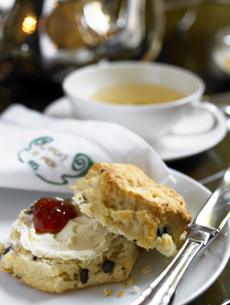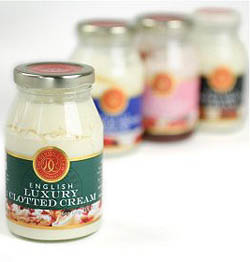Either way, clotted cream is as thick as soft butter, but it tastes like cream. While it has a minimum of 55% butterfat, it also is an excellent source of calcium, folic acid, magnesium, phosphorus, riboflavin, vitamins A, B12 and D and zinc. Devon cream, or double Devon cream, is virtually the same product with slightly less butterfat (48%). Clotted cream is made in other cultures, for different culinary uses. In India, it is called malai. In the Middle East and former Turkish Empire countries, it is called kajmak. In Mongolia, it is called öröm, and is added to salted tea. See more butter and cream terms in our Butter Glossary. Modern SconesIn the U.K., plain or currant scones are traditionally served with afternoon tea. First, the scones are spread with jam or lemon curd, then topped with a dollop of clotted cream. This is known as cream tea or Devonshire tea. In the U.S., where afternoon tea is a rare event, scones have joined muffins and croissants as a breakfast/brunch bread alternative, and as a snack bread. Plain and savory scones are substituted for other breads at lunch and dinner. Today, one can find recipes for more varieties of scones than there is time to bake them. There are buttermilk scone recipes, chocolate scones (and scones filled with chocolate chunks), treacle scones (with cinnamon, nutmeg, brown sugar and treacle, or blackstrap molasses), glazed and frosted scones (borrowing a page from the doughnut play book) and savory variations like cheddar-dill and Parmesan-garlic scones. Whatever your fancy, scones, essentially a sweet biscuit (but for the savory varieties), are best enjoyed at breakfast or brunch, and, of course, at afternoon tea. Substituting heavy cream for the butter and eggs in a traditional scone recipe will produce a moist, light scone, similar to a cream biscuit. A moist scone can be split like a shortcake biscuit, topped with berries and whipped cream and served for dessert. For some of our favorite scone mixes and recipes, visit the main page of our Bread Products section.
Lifestyle Direct, Inc. All rights reserved. Photographs are the copyright of their respective owners.
|

The Nibble Blog
The Latest Products, Recipes & Trends In Specialty Foods
The gourmet guide you’ve been waiting for. New food adventures are served up daily. Check it out!

Food Glossary
Our Food Directories Are "Crash Courses" In Tasty Topics
Your ultimate food lover’s dictionary packed full of information and historical references. Take a look!

Food History
Let the journey begin!
Learn about the history Of 1,000+ Favorite Foods & Beverages Let’s explore the history of your favorie goods together.Let the journey begin!


